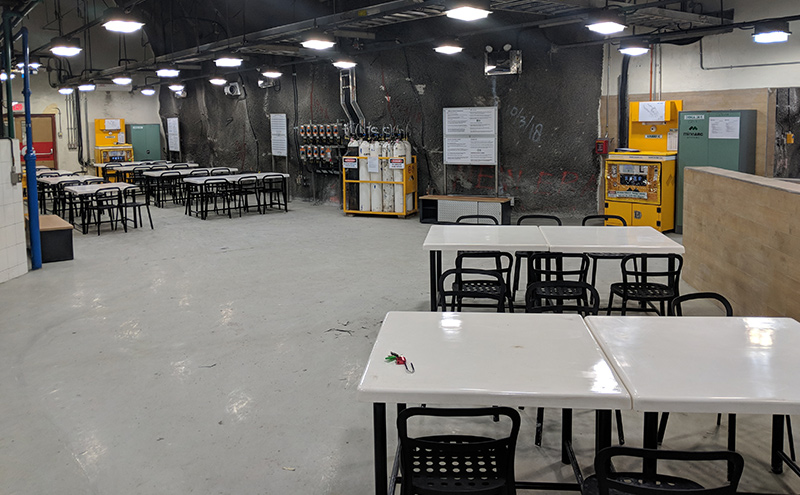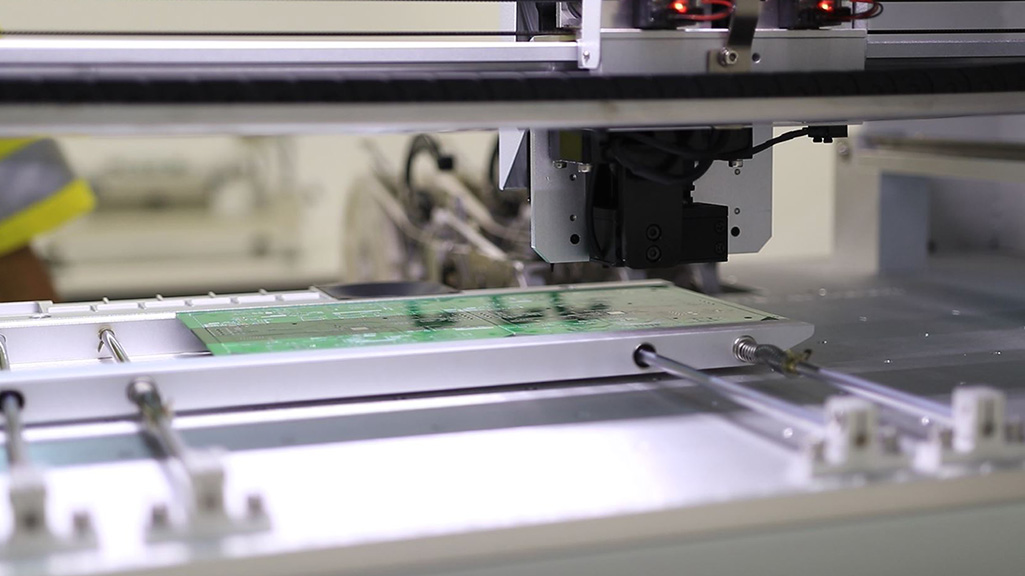Large scale operations can have thousands of personnel on-site during each shift. Therefore, a large, fixed refuge chamber’s dual-purpose capacity is a viable solution from an economic and safety perspective.
Safety and emergency response procedures must be designed to accommodate such a large number. Evacuation is always the primary course of action; the provision of Self-Contained Self-Rescuers (SCSR) diminishes the risk against the inhalation of toxic gases as personnel make their way to an exit. In large underground operations, a self-rescue device may not provide the duration to allow a wearer to escape to the surface, so alternative refuge locations must be considered.1
Emergency refuge stations form an integral part of an Emergency Response Plan (ERP) within heavy industry. Most sites have either portable or fixed refuge chambers. Portable refuge chambers can be relocated but have a limited capacity. Permanent refuge chambers, however, are in a fixed location and can generally accommodate larger groups.

Why Implement Large, Fixed Refuge Stations?
The typical layout of a mine site means most personnel are concentrated in smaller geographical areas. Therefore, for smaller mines, portable refuges can be implemented and relocated alongside the mine’s progress. However, it can be beneficial to have portable refuge chambers complemented by permanent refuge chambers with large scale mines.
Refuge chambers should be located within a reasonable distance from an active worksite. Some larger sites may choose to incorporate a permanent refuge chamber into their ERP; based on the following:
- The number of personnel underground at any one time, where the regular movement of personnel underground remains within certain areas.
- Repurposing crib rooms (lunch rooms) into multi-functional areas to be used as an emergency refuge station in a hazardous event.
- New personnel underground may not be familiar with the location of or travel routes to all refuge chambers on their first day; there is a higher likelihood they know the crib room location.2
- Excavation costs are low.
Incorporating fixed refuge chambers possess several non-traditional challenges that have to be addressed, specifically: mass ingress, multi-purpose spaces and hygiene.
Design Criteria for Permanent Refuge Chambers
Refuge stations are robust shelters built to sustain life in an emergency. There is a wide range of size and capacity options available. A fixed refuge chamber must contain, but not be limited to the following features outlined by the Western Australia Refuge Chambers in Underground Mines — Guideline.3
- Maximum Safe Distance: Refuge chambers should be a safe distance from all active working areas. Workers equipped with SCSRs of an average of 30 minutes should not be expected to walk further than 750 m to the nearest refuge station.
- Capacity: Built to accommodate the number of personnel during each shift within walking distance and accommodate additional visitors and contractors in the immediate area.
- Duration: If the external air supply is severed an independent supply of oxygen is required for a minimum of 36 hours at the nominated capacity.
- Power Supply: Under normal conditions, power is provided from the primary electrical system. If this fails a backup supply, e.g. batteries are required.
- Communications: Secure communications to a control centre or other staffed position are essential; options can include the use of leaky feeder systems, radio, and VOIP phones.
- Positive Pressure: Overpressure, relative to the external environment, prevents toxic gases and air contaminants’ ingress.
- Sealed Environment: Refuge chambers are closed environments to prevent the entry of pollutants such as smoke and hazardous gases from entering the enclosed space.
- Oxygen Supply: A supply of oxygen, from mine air or oxygen cylinders, needs to be continuously monitored and controlled to levels no less than 19.5% and no greater than 22% by oxygen volume.
- Air Scrubbing: Refuge chamber scrubbing systems use chemical reactions to remove contaminants, carbon dioxide and carbon monoxide, from the air by changing the composition of gases exhaled by inhabitants.
- Gas Monitoring Equipment: Electronic or manual equipment to determine the breathability of air within the refuge chamber must be supplied.
- Environmental Control: Temperature and humidity can effectively be controlled through refrigerated air conditioning. Equipment should be robust and of sufficient capacity to handle underground conditions.
- Hygiene: Toilet facilities are essential
- Potable Water: Safe, drinkable water is required for the minimum duration; recommended at least 4.5 litres of water per person.
Permanent Refuge Chamber Design Challenges
Maintaining Positive Pressure
Positive pressure prevents the ingress of contaminants from entering the refuge. Smoke and other toxic gases can significantly decrease the breathability of air within a refuge station.
Maintaining positive pressure within a large sealed environment is achievable. However, due to fixed refuge chambers’ capacity, this becomes more difficult when large numbers of occupants enter the refuge. As the entry is large enough, and often open long enough for the atmosphere to equalise, contaminants may enter the chamber.
Reducing the air contamination, while still allowing large groups of personnel to enter, is critical. An airlock is a proven method to help minimise contaminants’ entry to both fixed and portable refuge chambers. Correctly using an airlock would require a site to extend the entry time well beyond an acceptable rate. One solution is the development of a high flow airlock system.
High flow airlocks use air curtains to purge contaminants that may pass an airlock if not correctly used. A high flow airlock still requires dual doors. The refuge entry process opens the first door, which automatically starts the air curtain system and then continues through to the second door to enter the refuge chamber. Both doors will remain open and only finally close once all near-by personnel have completed the entry process. The use of an air curtain on entry into a refuge chamber would provide sufficient protection against breathing contaminant ingress. With the size of large refuge chambers, any entrained smoke on an entry will not contaminate the chamber to a point where chemical scrubbing is required.1
Large Refuge Bays as Multipurpose Rooms
Building a large capacity permanent refuge chamber for a single purpose can appear uneconomical. Designing the chambers to be dual purpose, e.g. crib rooms can provide more return on investment. Permanent chambers built for multiple purposes must consider the security of emergency supplies that need to be incorporated into the design.
Emergency water, food and equipment need to be protected. The design must address the possibility of damage to equipment from everyday use and the protection of emergency supplies. Storing supplies within locked areas or units can prevent casual access.
Protecting equipment can be more difficult as they cannot be easily stored away. Because this equipment is in plain sight, there is a risk of life-sustaining mechanisms such as scrubbing systems and oxygen supplies being damaged through mishandling and unintentional damage. Specially designed covers, ongoing training and monitoring systems can be employed to reduce this risk.
Hygiene and Sanitation in Refuge Bays
Adequate sanitation is critical to the health and safety of personnel. The number of self-contained toilets must meet the usage needs of a full capacity chamber. If dual purpose, the design needs to consider if the toilets are exclusively for emergency use, or if they are also available during normal operations.
Designing a permanent refuge chamber to support a more substantial occupancy during an emergency is proven to be a viable option for sites. Combining portable and permanent refuge chambers into their overall ERP ensures personnel have adequate options to take refuge during a hazardous event. Key considerations of the design need to be addressed to ensure safety requirements are maintained, and the installation is economically viable. It is important to recognise that additional design specifications are dependent on the risks present at the individual mine.
Because of the complexity of large-scale permanent refuge chamber, the protection of life in large volumes requires special considerations. MineARC is the only company with the engineering capabilities to fully assess each customer’s site-specific requirements and provide hard engineering calculations to validate any equipment selection.
References
- Paul Meisburger E., Iryanto D., Quinn D., Widyastutie A., Mone A. (2019) Design and Construction of High Capacity Fixed Refuge Chambers at PT Freeport Indonesia’s Underground Operations. In: Chang X. (eds) Proceedings of the 11th International Mine Ventilation Congress. Springer, Singapore https://link.springer.com/chapter/10.1007/978-981-13-1420-9_73
- D J Brake and G P Bates. “Criteria for the design of emergency refuge stations for an underground metal mine” Published in Journal of the AusIMM, December 1999. Copyright AusIMM. https://ausimm.com/product/criteria-for-the-design-of-emergency-refuge-stations-for-an-underground-metal-mine/
- Department of Mines and Petroleum, 2013, Refuge chambers in underground mines — guideline: Resources Safety, Department of Mines and Petroleum, Western Australia, 41 pp.







